Delhi: Land-related issues; encroachment; unauthorised colonies
This is a collection of articles archived for the excellence of their content. |
Contents |
The extent of the problem
2016/ Encroachment: North Delhi
The Times of India, Dec 21 2016

Chandni Chowk to Narela: North corpn to drive out encroachers
Mayank Manohar
North Delhi Municipal Corporation is set to remove vehicles permanently parked in highly congested markets like Chandni Chowk, Jama Masjid, Paharganj, Ashok Vihar, etc, after the NGT ordered Delhi's civic bodies to clear market areas of all encroachments. P K Gupta, commissioner of North Delhi Municipal Corporation, said they have identified 12 major places for the drive in the first phase, after which it would be expanded to other areas.
North Corporation has selected Chandni Chowk, Jama Masjid area, Tank Road, Gaffar Market, Raj Niwas, Ashok Vihar market, Narela main road, Alipur market, Jwala Heri mar ket, RG Complex Prashant Vihar, Ram Nagar, and Paharganj in the current drive.
“We will remove abandoned vehicles and start night sweeping at these places in the first phase. Old, abandoned cars not only clog the market, they also affect sanitary conditions of the area. Most of these cars have been parked here for several months, a few have been even lying here for the last couple of years. We have requested traffic police to assist us in this job,“ Gupta said. Traders in these areas are divided over the decision. “At least 15-20 vehicles have been parked in and around Paharganj market for a long time.These vehicles mostly belong to the residents of nearby areas, while a few are owned by some traders. We welcome the corporation's drive,“ Yogesh Kathuria, president of Paharganj market association, said.
Traders in Chandni Chowk and Jama Masjid area say that several proposals were made by the corporation in the past, but nothing has moved on the ground.
“They proposed several things to decongest Old Delhi in the past. Almost 25% of Parade Ground and Gandhi Maidan's multilevel, under ground parking facility is taken up by abandoned cars. Every lane of Chandni Chowk, Ballimaran, Dariba Kalan, and Jama Masjid areas is choked by several disused, rusting, and abandoned cars. Old Delhi will become a much better place once all these cars are removed,“ said Naresh Khanna, president of the jewellers' association of Dariba Kalan market.
The situation is much the same in most of the market places in North Corporation. “We have several vacant plots in Narela where we will dump the abandoned vehicles for the time being,“ Gupta said.
2018: 1,250 acres of forest, gram land in S.Delhi encroached
Alok KN Mishra, Forest land 4 times the size of Prez estate occupied illegally in S Delhi, July 24, 2018: The Times of India|frame|500px]]
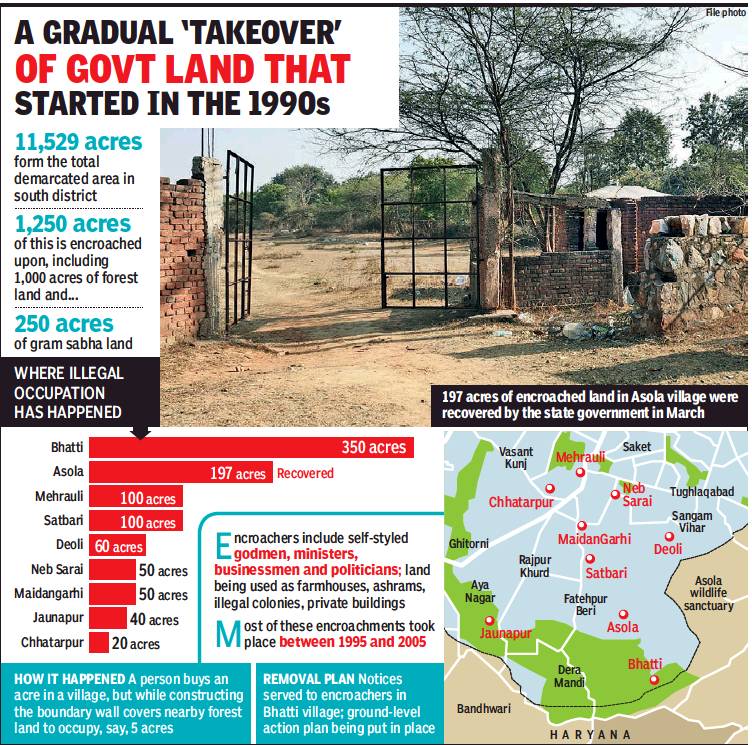
From: Alok KN Mishra, Forest land 4 times the size of Prez estate occupied illegally in S Delhi, July 24, 2018: The Times of India
Demarcation Of 11,529 Acres Completed; 1,250 Acres Found To Be Encroached Upon
Self-styled godmen, politicians, businessmen, even celebrities, are among the people who have illegally occupied 1,250 acres of forest and gram sabha land in south Delhi. This is nearly four times the size of Rashtrapati Bhavan (320 acres). Of this, 197 acres of encroached land in Asola village in the same district were recovered by the state government in March.
Encroachment of this magnitude is ironical considering that several public welfare projects, such as sewer treatment plants, have been held up due to the lack of land for their establishment.
This mammoth encroachment was uncovered after Delhi government’s revenue department completed the demarcation of the 11,529 acres of government land in south district to gauge the scale of forest and gram sabha land lost due to illegal occupation. Sources in the revenue department said that the existing value of the land — some located in prime areas — is over Rs 3,000 crore.
“The demarcation of the land was a long pending exercise and it has finally been completed,” said Amjad Tak, district magistrate (south). “We are committed to retrieving all the encroached land for which an action plan is being prepared. After recovering the land from the encroachers, we will put up fencing to see that the retrieved land is not occupied again.”
Civic authorities contend that the gradual encroachment began in the late 1990s. The illegal takeover of government land increased in the late 2000s, with the authorities at different levels allegedly turning a blind eye to these acts. “The encroachers acted very smartly often fooling the police and the authorities,” said a source.
For example, one person purchased an acre land in a village, but while constructing the boundary wall, he took over additional forest or gram sabha land abutting his plot and ultimately expanded the size of his holding into almost five acres. “The same modus operandi was used by most of the selfstyled godmen, celebrities, politicians and businessmen who used their influence to encroach forest and gram sabha land,” said one of the sources. “Many of them converted natural drains and even small water bodies into land by filling them up with debris or garbage.”
This wretchedness of the situation was compounded by illegal real-estate developers who purchased a few acres from farmers and then encroached on neighbouring forest areas to expand their colony plans. “This led to the development of several illegal colonies in violation of all the building bylaws and without regard for norms,” explained a source. The encroachment not only affected the area’s forest cover, but also led to the vanishing of several small water bodies when the land sharks converted them into plots. “The eight water bodies that once existed on the records of the revenue department in the areas under encroachment have vanished. Many wells in the areas have also gone dry,” revealed an official.
Over the years, this has led to a sharp rise in the pollution levels accompanied by a big fall in the water table. “Some illegal colonies in Fatehpur Beri, Asola and Bhatti villages face huge water logging during the monsoon months,” remarked an official.
The situation, however, might change for the better. A couple of months ago, 197 acres of land extensively encroached in the form of far mhouses and per manent and temporary structures were demolished to recover the occupied expanses. Much of the retrieved land has been handed over to the forest department.
Directions for the removal of the encroachment have come from the National Green Tribunal and the committee monitoring building violations in the capital on the Supreme Court’s direction. Notices have already been served to occupants in Bhatti village to remove all kinds of encroachment for have their possessions removed by the district task force. “Some people had filed the cases in Delhi high court, and the court has dismissed them,” one of the sources disclosed. “The grievances of the encroachers are being addressed. When this is over, the district authorities will take steps to remove the encroachment in around one month.”
Land pooling
See graphic
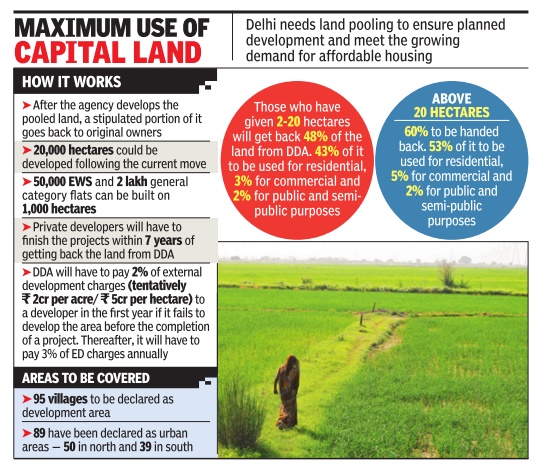
Lessons from Narela, Rohini
Risha Chitlangia, What DDA should learn from Narela and Rohini, May 20, 2017: The Times of India
With Delhi government clearing the way for implementation of the landpooling policy -seen as a way out of the city's housing problem -there appear to be more questions than answers. Residents of the newly constructed DDA residential complexes at Narela sector G-2 and Rohini sectors 34 and 35, for example, have a common grievance: a glaring lack of civic infrastructure and amenities as basic as water.
The land-owning agency plans to announce a housing scheme in mid-June to resell close to 13,000 flats that were returned by allottees of the 2014 housing scheme: one of the main reasons for this was a lack of basic infrastructure, which was highlighted by TOI in a report titled, “On sale again, these flats lack basic infra“, on November 29, 2016.
Vaibhav Puggal, president of sector 35, pocket 5, in Rohini, said: “They (DDA) allotted flats without developing roads, markets, etc. While the agency is carrying out development work, it is not adequate.“ In Narela's G-2, residents complained of an acute water shortage. They said the current supply was inadequate to cater to the demand of 250-odd families living in the complex, which had 2,156 flats. DDA supplies water through tankers to the main storage tank in the complex. This is later pumped into houses. “There is a shortage of water. Close to 650 flats were allotted here, but only 250 families have shifted so far. People are not moving in due to the water crisis and a lack of other infrastructure,“ said Pratap Singh, RWA president.
Singh said they had written to Delhi LG, DDA vicechairman, area MLA, and then water minister Kapil Mishra about their problems, but “nothing has been done so far“.
DDA officials, however, maintained that work was on in full swing in these areas.“We will announce the new housing scheme in mid-June.Work is going on these areas to ensure that infrastructure is in place,“ said JP Aggarwal, principal commissioner, land disposal and housing, DDA.Now with land-pooling policy getting a push, the demand for water is only going to increase. In the next 2-4 years, DDA will construct close to 80,000 flats in the city , as development under land pooling will take at least 7-8 years.
But Delhi Jal Board, which supplies 900 million gallons per day in Delhi, said that it did not have more water to meet the growing demand. While getting additional raw water in the near future was a remote possibility , DJB officials said they were working on projects like recycling and reusing water apart from plugging leakages to augment the supply .
Residents said both the government and DDA should first focus on areas already developed by DDA -like Rohini, Narela and Dwarka -before allowing construction under land pooling. “When there is no water for existing flats, how will the government meet the fresh demand? Our areas should be their priority as people have invested their life's saving in these flats,“ said Puggal.
J P Aggarwal, principal commissioner (land disposal and housing), DDA, said:“We have taken up the matter of starting direct supply of water in these areas with DJB.Hopefully , this will happen in the next few months.“
In fact, DDA officials said, efforts were on to ensure regular supply of water to all developed areas. While urban planners claimed that land pooling would help in planned development, they added that it was imperative that basic amenities were taken care of, to begin with. “We should learn from past mistakes.There is a need for proper planning and enforcement to ensure newly planned areas get all essential services,“ said Sanjukkta Bhaduri, urban planner and professor, School of Planning and Architecture.
89 villages made urban areas: 2017
40,000 Acres To Be Freed For Development
Lieutenant-governor Anil Baijal has bypassed the Arvind Kejriwal government and notified 89 villages as urban areas. This will pave the way for land pooling, which would make around 40,000 acres of land available for development.
The proposal to allow land pooling is almost a decade old. Delhi Development Authority had notified the policy in June 2015. But it could not be implemented as the state government refused to change the land use of the villages' agricultural land.
To change the land use, the first step was to change the character of the village from rural to urban area, which was notified on Tuesday. In the second step, the agricultural land of the farmers of the villages will be declared as “development area. After this, farmers can give land to DDA for land pooling.
This is expected to lead to pooling of around 40,000 acres of land on the outskirts of Delhi, which is the size of the industrial and residential area in Noida combined.
Under the proposed policy , if a farmer or a group of farmers gives more than 20 hectares (50 acres) of land to DDA, the authority will return 60% of the land after developing it.For less than 20 hectares, DDA will return 40% of the land. On the rest of the land, DDA will provide common facilities like road, sewer, water supply and other basic amenities.
D DA will meet the cost of development by selling the developed land left with it to developers or end users. The land given back to the original owners by DDA can be used for housing or any commercial development.
A Delhi government spokesperson refused to term the process of notification as bypassing the state government. He said there was file movement for the purpose.The minister's approval was not required as the department handling land issues is not part of the state government.
Leader of opposition in the Delhi assembly Vijender Gupta said the notification was due to the LG taking direct cognisance of the issue.He said this augured well for the development of Delhi as it shows that the LG has decided to take determined action on developmental issues. Therefore, it is expected that the next move to declare the agricultural land as urban development area will also come soon and the LG will not wait for a nod from the Kejriwal government, he said.
All land outside “lal dora the area demarcated for village residential areas-has to be declared as development area. After that, the land use will automatically become non-agriculture.
The Union government has been asking the Delhi state government to expedite the process of announcing a land pooling policy so that development activities could be accelerated in the state. However, the Kejriwal government had asked for 10% of the developed land to be allotted to the state government. The Centre had refused, saying that land would be allotted to the state government as and when it would demand it for legitimate use.
2018: DDA approves land pooling policy
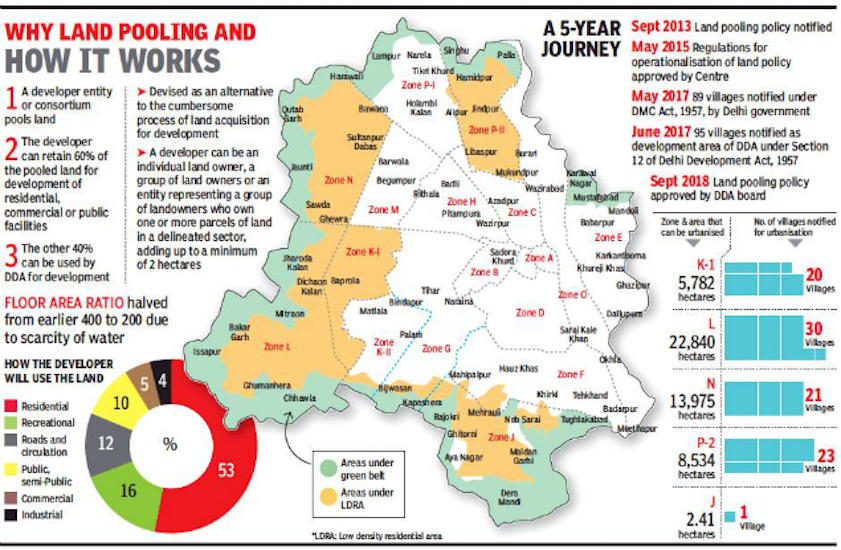
From: 17 lakh houses to be built as land pooling policy gets DDA nod, September 8, 2018: The Times of India
The land pooling policy, which has been in the works for the past five years, was finally cleared at the Delhi Development Authority's board meeting.
It has paved the way for construction of over 17 lakh houses, projected to accommodate 76 lakh people. The policy will now be sent for approval to the Union ministry of housing and urban affairs. lan
First notified in 2013, the policy aims to provide affordable housing by circumventing the cumbersome process of land acquisition which is the conventional model of land development. This process often gets mired in litigation due to complaints of paltry compensation. The new policy will allow pooling of land by developers who can retain 60% of the developed land for residential and commercial use apart from providing public facilities.
How pooling will unlock vast tracts of land
Fringe Areas Of City To See Development, But FAR Halved To 200 Due To Scarcity Of Water
The policy will help unlock vast tracts of land for residential and commercial development in the fringe areas of Delhi as it covers urbanisable areas in 95 notified villages. While the policy initially aimed at providing 24 lakh houses, the figure has been revised to 17 lakh as the original 400 floor area ratio (FAR) promised in the policy has been reduced to 200 owing to scarcity of water and other resources.
FAR is the ratio between the total amount of usable floor area that a building has and the total area of the plot on which it stands. This ratio is determined by dividing the total floor area of the building by the area of the plot. “FAR and density norms have been provided for effective resource-based planning. Considering the availability of resources and services, FAR of 200 has been recommended for development in the policy keeping in view availability of water, requirement of land for physical and social infrastructure and impact on environment,” a DDA spokesperson said.
DDA said that a 200 FAR is adequate for developing public and semi-public amenities and will make land pooling economically viable besides achieving a reasonable internal rate of return. “In order to promote affordable and inclusive housing, a 15% FAR over and above the permissible FAR has also been allowed for affordable housing. Out of the total of 17 lakh dwelling units, more than five lakh dwelling units will be created for the economically weaker sections,” he said.
Land owners who possess two hectares or more can take advantage of the policy. A developer entity or individual can participate in the scheme by pooling land parcels covered under a sector as per the zonal development plan. An integrated sector-based planning approach will be followed. A sector will be comprise of 250 to 300 hectares. Once a minimum of 70% contiguous land of the developable area free of encumbrances is assembled, it will be eligible for development.
DDA has introduced the provision of vertical mix of uses (residential, commercial, public) at building level. “Additional development controls have been introduced to regulate building and infrastructure aspects of development. Compensation in the form of tradable FAR has been introduced to allow the developer to utilise the entire allowable FAR within the 60% land,” said the spokesperson.
The service providing agencies will take up development of trunk infrastructure such as roads, water supply, electricity, greens, social infrastructure etc. within 40% of the land area retained by DDA. The developer too will take up internal development of land under residential, commercial and public and semi-public facilities as per the policy.
New developments under the land pooling policy will have to comply with green building norms and use dual pipeline, make maximum use of recycled water for non-potable purposes, conserve rain water and deploy zero waste technology etc. “ A minimum 10% of all energy consumption shall be through solar power or through other renewable energy sources,” the spokesperson said.
DDA is creating a singlewindow system for implementation of the policy and promises to complete all processes, including receiving applications, verifications, grant of approvals and licences etc. in a time-bound manner. A two-stage grievance redressal mechanism has been put in place.
2018/ DDA lays down ground rules for land pooling policy
October 26, 2018: The Times of India
The Delhi Development Authority has notified regulations for the operationalisation of the land pooling policy.
A minimum 70% of developable area in a ‘sector’ must be pooled for development under the policy and the pooled land parcels must be contiguous and free of encumbrances. The developer will retain 60% of the pooled land for residential (53%), commercial (5%) and public facilities (2%), while the rest of the 40% will be used by DDA for developing city level infrastructure, include recreational and public facilities.
The regulations state that land policy will be implemented simultaneously in the entire urbanizable areas of the urban extension and, if required, rollout of the policy may be phased. The entire process will be operated through an online singlewindow system and DDA will announce ‘application windows’ for a fixed duration of time, during which applications will be received and processed.
Once 70% contiguous land is achieved within a sector and is verified by the revenue department, such sectors will be considered eligible for development and DDA will issue a notice for formation of ‘consortium’, which will be a single entity of constituent landowners. The consortium will then prepare a implementation plan with consent of all landowners. The consortium will then apply to DDA as a single entity for undertaking development within the sector.
DDA will prepare a plan at the sector level, specifying the location of 40% land required for development of city level physical infrastructure, roads, industrial, recreational and public and semi-public facilities, apart from the location of 60% land available for development by the consortium.
The single-window system will be used by the consortium to submit layout plans with detailed service plans and building plans as per building bylaws to the regulatory agencies. Based on the plans, DDA will first issue a provisional development licence and, then, a final development licence. The final development licence will be valid for 10 years, during which infrastructure development work has to be carried out to get a completion certificate from DDA.
2021: Land Pooling made Flexible, Attractive
Sidhartha Roy, Sep 15, 2021: The Times of India
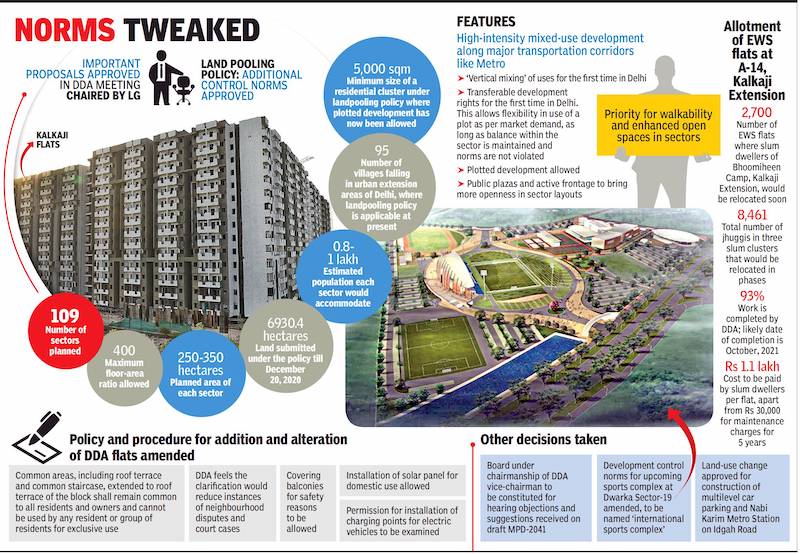
From: Sidhartha Roy, Sep 15, 2021: The Times of India
Delhi Development Authority gave its final approval to additional development control (ADC) norms for areas notified under its ambitious land pooling policy, in order to make it more attractive for landowners & private developers.
The proposed ADC norms, which would see implementation of new features like vertical mixing and transferable development rights for the first time in Delhi, were approved at the Authority’s meeting chaired by lieutenant governor Anil Baijal.
The policy, which was notified in 2018 and aims to overcome the cumbersome process of land acquisition by making landowners equal partners in the development process, has seen 6930.4 hectares of land submitted for pooling till December 20, 2020, through a web portal launched in February 2019. While DDA is to play the role of a facilitator, it is working towards initiating planning and development in some likely-to-be eligible sectors. Officials admitted, on the condition of anonymity, that though overall enough land has been pooled to create a sub-city, the land parcels are scattered and need readjustment as the response from landowners has been far short of what was expected.
“That is why, these ADC norms have been brought to allow more flexibility to developers and make the policy more attractive. Now mixed use in the land pooling areas has also been approved, including highintensity mixed-use development along major transportation corridors,” said an official.
Vertical mixing, a first for the capital, would allow multiple uses in a single structure with maximum FAR of 400 and transferable development rights, which is a new concept for the capital. It would be possible to build more commercial spaces in the pooled area or more residential ones, depending on the market demand. “For instance, flexibility to convert commercial use to residential has been permitted as long as the norms are not violated. The development should not be monotonous, and developers can take up land pooling projects based on market demand,” said the official.
The total area that can be built at the sector level can be varied or loaded across different plots in a sector but without exceeding the maximum FAR limit of the sector, so that an overall balance is maintained.
The new norms also allow plotted development in areas notified for land pooling in a cluster of a minimum size of 5,000 sq m on a net residential plot. Priority has been given to walkability, enhanced open spaces, public plazas and active frontage in the sectors. The proposed ADC norms will now be forwarded to the union ministry of housing and urban affairs for its consideration and final notification. The policy is at present applicable in the urban extension areas of Delhi, comprising 95 villages. The entire area is divided into 109 sectors, with an average area of 250 to 350 hectares in each sector, which are expected to accommodate a population of 80,000 to1 lakh.
Other important decisions taken by the Authority include constitution of a board for reviewing the objections and suggestions received on the draft Master Plan for Delhi-2041. DDA is working towards getting the final approval for MPD-2041 by December.
DDA also approved modification of the nomenclature for a plot earmarked for a sports complex in Dwarka’s Sector-19 to name it International Sports Complex. The area is expected to become an entertainment and tourist destination with real estate development like hotels, retail, convention centre, residential, etc. It was decided at the meeting that facilities would be available to public not only on the basis of membership but through pay-and-play services too.
DDA also changed the land use from residential to transportation for a multi-level car parking facility at Idgah Road, which would help north corporation and DMRC to construct the facility, which is coming up as an integrated project with the proposed Nabi Karim interchange Metro station of Phase IV.
Legalising unauthorised colonies
HC: legalising unauthorised colonies creates problems
The Hindu, January 4, 2017
Akanksha Jain
The Delhi High Court said that jhuggi jhopri (JJ) clusters are normally “born out of need” and unauthorised colonies are “born out of greed” while rejecting the petition of a colony for regularisation.
The court observed that legalising unauthorised colonies in the past has emboldened encroachers besides causing environmental degradation, traffic bottlenecks and spread of diseases such as malaria due to lack of drainage facilities.
“It is pertinent to mention that people who have set up these unauthorised colonies have neither paid full development charges to the civic authorities nor provided proper civic facilities like roads, sewerage, drainage, water and electricity, and as a result of this, diseases like malaria, diarrhoea and tuberculosis are common in Delhi,” said Justice Manmohan.
‘Haphazard construction’
“It goes without saying that is extremely difficult if not impossible to provide adequate and proper sewage, drainage and roads after an unplanned colony has been constructed and occupied. After all, if the construction has been carried out in a haphazard manner without adhering to any scientific norms like grid pattern, how can a road with adequate width be subsequently provided,” he added.
The court made the observations while deciding in negative a petition filed by Utsav Vihar Residents Welfare Association seeking direction to the DDA to not encroach/ dispossess any member of the colony from its land.
Regularisation plea
Utsav Vihar is an unauthorised colony which came up in 1992 on a private agricultural land of Karala village. It is among the colonies seeking regularisation by the Delhi government. Part of the colony falls within the alignment of the roads proposed by the Delhi Development Authority.
The Utsav Vihar RWA had come to the court with a plea not to dispossess it from the land and also sought a direction to the civic agency to proceed under the Right to Fair Compensation and Transparency in Land Acquisition, Rehabilitation and Resettlement Act, 2013, in case any land forming part of the colony is required for any public purpose.
Land acquired by DDA
The DDA, on the other hand, said it had acquired the land in 2007 after affecting demolition and that the land falling in the alignment of 100 metre road has only about nine properties and the RWA cannot seek relief for the entire colony on that basis.
The court was also informed that the colony's representation dated September 22, 2012 for regularisation had been rejected on the ground that the land was required for construction of a public road.
The RWA was contending that the acquisition has lapsed with the DDA failing to take over the possession of the land.
The court, however, was of the view that affected persons would have to file individual writ petitions and “till the time the appropriate court does not declare that the acquisition proceeding has lapsed, this court is of the view that the right of DDA to the land cannot be questioned”.
On regularisation, the court said since the colony's representation stands rejected and not challenged for two years, no relief can be sought in relation to it.
2019: The Central Govt. does so
Atul Mathur, Oct 24, 2019: The Times of India
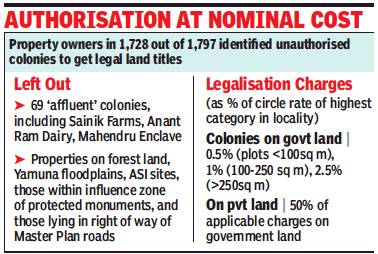
From: Atul Mathur, Oct 24, 2019: The Times of India
According to an estimate, the revenue department will have to register about 18 lakh properties (calculated on the basis of electricity connections in 1,797 illegal colonies) once the regularisation notification is issued.
The properties in unauthorised colonies initially changed hands on the basis of general power of attorney (GPA). After the government banned registering GPAs, sources said people sealed deals on stamp papers attested by notaries.
Sources, however, said that conferring ownership rights might not start until DDA delineated the boundaries of each colony and finalises maps identifying the houses and public amenities such as roads, parks and community facilities. This could take a couple of years.
Kejriwal cautioned that carrying out a fresh survey of colonies to define their boundaries would take time. He proposed that the boundaries could initially be identified through geo-spatial digital maps, which are ready.
“In our suggestion sent in July, we had said that the registration of properties should be started on the on the basis of satellite maps prepared by Geospatial Delhi Limited (GSDL) to speed up the process. The detailed maps could be prepared alongside,” the CM said.
A proposal sent by Delhi government in November 2015:
“We had proposed that the cut-off date for regularisation should be March 31, 2019 instead of January 1, 2015. We had also proposed that all colonies falling beyond the Yamuna bund should be regularised even if they were falling in Ozone. Another proposal was to leave out only that part of a colony which was on forest land or in ASI-protected areas and regularise the rest,” Kejriwal said.